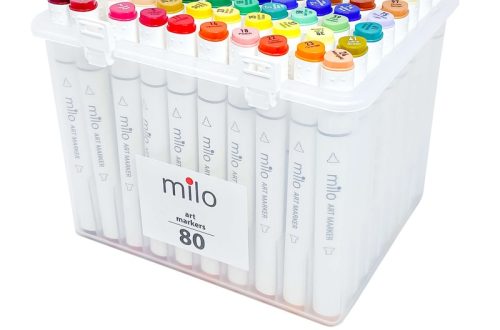Part 1: Drawing and Sketching Supplies
1. Pencils:
In addition to graphite and colored pencils, consider getting watercolor pencils for versatility in your artwork. Watercolor pencils can be used dry or with water to create a watercolor effect, allowing for different techniques and styles in your drawings. The diverse range of pencils will provide you with the flexibility to experiment with various mediums and styles, enhancing your skills as an artist. Furthermore, having a set of high-quality pencils will enable you to achieve fine details, shading, and blending in your drawings, ultimately elevating the overall quality of your artwork. A good set of pencils is a fundamental investment for any art student, offering a wide range of possibilities for creative expression and artistic exploration.
2. Sketchbook:
A high-quality sketchbook is an indispensable tool for artists, providing a platform to explore and develop their creativity. When choosing a sketchbook, it’s crucial to consider the weight and texture of the paper, ensuring it can accommodate different mediums without bleeding or warping. Look for a sketchbook with a heavyweight paper, designed to withstand pencil, ink, markers, and even light watercolor applications. Additionally, consider the size and binding style that align with your artistic preferences and mobility. Whether you favor a spiral-bound sketchbook for easy flip-through or a hardbound one for a classic feel, the right sketchbook will facilitate freedom of expression and serve as a valuable repository for your artistic journey. A high-quality sketchbook not only preserves your creations but also inspires you to continually hone your skills and materialize your artistic vision.

Part 2: Painting Supplies
1. Paint:
When it comes to painting, the choice of paints can significantly impact your artistic expression. For watercolor painting, opt for a high-quality set of watercolor paints offering a range of colors to suit your creative endeavors. Look for pigments with good lightfastness and transparency to achieve vibrant and long-lasting results. For acrylic painting, a selection of essential colors in durable and versatile acrylic paint is essential. These colors can be used straight from the tube or mixed to create a variety of hues to suit your artistic vision. When working with oils, invest in a set of quality oil paints with excellent pigmentation and consistency.
The selection of colors will depend on your preferences and the style of painting you wish to pursue. Additionally, ensure you have a suitable mixing palette and brushes designed specifically for the type of paint you’ll be using, allowing for greater control and precision in your artwork. Investing in high-quality paints and paint accessories is crucial for achieving the best possible results in your paintings.
2. Canvas or Paper:
When working with acrylics or oils, the choice of canvas panels or stretched canvases is essential. Canvas panels are excellent for outdoor painting or when you need a portable surface, while stretched canvases provide a professional and ready-to-hang option for finished pieces. The texture of the canvas impacts the brush strokes and overall look of the painting, so consider the desired effect when selecting your canvas. For watercolor painting, investing in high-quality watercolor paper is crucial. Look for paper specifically designed to absorb and showcase the subtleties of watercolor paint.
The weight and texture of the paper will affect how your colors diffuse and mix, influencing the final appearance of your artwork. It’s important to stock up on quality surfaces that are suitable for the specific medium you’ll be using to ensure your art pieces have the best possible foundation and can withstand the techniques and materials used in the creative process.
Part 3: Mixed Media Supplies

1. Glue and Adhesives:
When venturing into the realm of mixed media art, a selection of adhesives is essential to seamlessly integrate diverse materials into your artwork. For paper-based collages and mixed media projects, consider using acid-free glue sticks, which provide a quick and mess-free way to adhere paper elements onto your substrate. Additionally, white glue is versatile and ideal for attaching heavier materials or creating texture within your artwork. Its strong bond and flexibility make it suitable for adhering various objects and materials.
Double-sided tape is perfect for creating clean and secure attachments, especially when working with delicate or transparent materials. Look for products that are specifically designed to be safe for use with paper and other mixed media elements to ensure the longevity and quality of your art pieces. The right selection of adhesives will support your creative vision, allowing you to explore the endless possibilities of mixed media art while maintaining the integrity of your compositions.
2. Collage Materials:
When delving into the captivating world of collage art, it’s essential to curate a diverse assortment of materials to enhance the depth and complexity of your compositions. Look for an array of decorative papers, including patterned, textured, and specialty papers, to introduce visual interest and dimension to your collages. Incorporating fabric scraps adds a tactile element and introduces a dynamic texture to your artworks. Found objects, such as ephemera, vintage photos, or small trinkets, infuse a narrative quality and personal significance into your creations.
To further expand the creative potential of your collage work, consider incorporating rubber stamps and ink pads to add unique patterns, textures, and motifs. Stencils can also provide an endless array of design possibilities, allowing for the addition of intricate details and layers to your collages. By stocking up on a versatile selection of materials and tools, you can unleash your creativity and craft captivating collages that reflect your artistic vision and storytelling aspirations.
Part 4: Printmaking Supplies
1. Printmaking Ink:
When embarking on the art of printmaking, securing a comprehensive range of high-quality printmaking inks is essential to achieve vibrant and enduring results. An assortment of inks in a spectrum of colors allows for creative freedom and versatility in your printmaking endeavors, empowering you to execute your artistic vision with precision. Opt for inks that offer excellent permanence and lightfastness, ensuring that your prints retain their color intensity and resist fading over time. Consider the viscosity and consistency of the inks to accommodate different printing techniques and surfaces, providing the flexibility to create varied textures and effects in your prints.

Additionally, explore specialty inks, such as metallic or transparent inks, to introduce captivating nuances and visual depth to your prints. By investing in a diverse selection of high-quality printmaking inks, you can elevate your printmaking practice, enriching your creations with vivid and enduring colors that captivate and endure.
2. Printmaking Tools:
Depending on the type of printmaking you’ll be doing, you’ll need a variety of tools, such as carving tools for linoleum or woodcuts, and brayers for transferring ink to your printing surface.
Part 5: Sculpting Supplies
1. Clay:
If you’ll be working with clay, be sure to stock up on a good-quality, air-dry or kiln-fired clay in a variety of colors. Consider adding sculpting tools, such as wire loops and modeling tools, to your collection.
2. Armature Materials:
If you’ll be sculpting larger pieces, you may need armature materials, such as wire, foam, or aluminum armature mesh, to provide the support needed for your sculptures.
Part 6: Organizational Supplies
1. Storage Containers:
Keep your art supplies organized and easily accessible by investing in a variety of storage containers, such as pencil cases, art supply caddies, and plastic bins with dividers.
2. Art Portfolio:
Invest in a high-quality art portfolio for storing and transporting your finished artwork. Look for one that is durable, weather-resistant, and large enough to hold your largest pieces.





